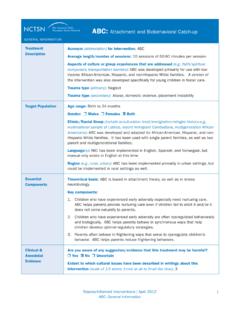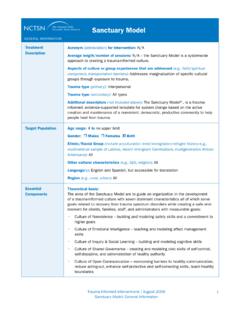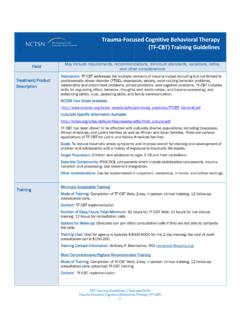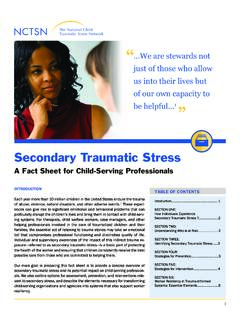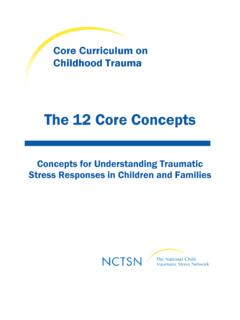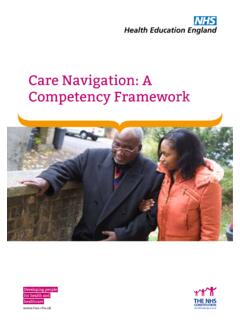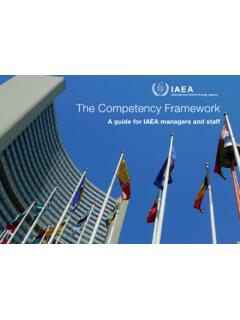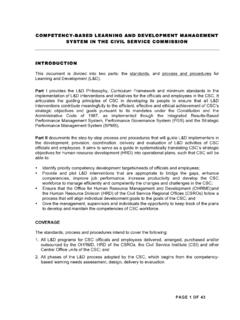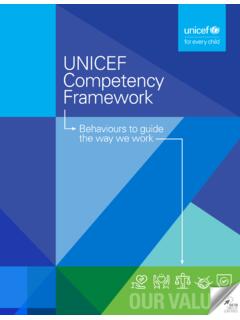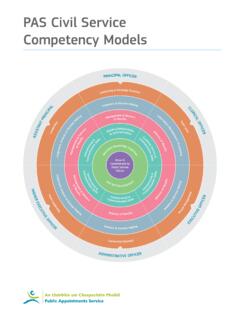Transcription of ARC: Attachment, Self-Regulation, and Competency: A ...
1 1 ARC: Attachment, Self-Regulation, and competency : A Comprehensive framework for Intervention with Complexly Traumatized YouthGENERAL INFORMATIONT rauma-Informed Interventions | April 2012 ARC: General InformationTreatment DescriptionAcronym (abbreviation) for intervention: ARCA verage length/number of sessions: Dependent on individualized implementation and modality. Generally the number of sessions can range from 12 to greater than 52 sessions. ARC has multiple modalities including individual, group and family treatment; parent workshops; milieu/systems intervention; and a new home based prevention program.
2 Aspects of culture or group experiences that are addressed ( , faith/spiritual component, transportation barriers): framework is designed to be adaptable to needs and real-life circumstances of clients ( , identifying culturally relevant caregiver supports; working with appropriate members of family / kinship system). framework specifically targets the child s surrounding system (caregiver(s), treatment system, community).Trauma type (primary): Complex Trauma; Target population has experienced chronic stressors including early childhood trauma and ongoing exposures to adverse life experiences.
3 Additional descriptors (not included above): The approach is grounded in attachment theory and early childhood development and addresses how a child s entire system of care can become trauma informed to better support trauma focused therapy. The approach provides a framework for both trauma informed and trauma specific therapeutic intervention. Target PopulationAge range: 2 to 21 Gender: r Males r Females r BothEthnic/Racial Group (include acculturation level/immigration/refugee , multinational sample of Latinos, recent immigrant Cambodians, multigeneration African Americans): AllOther cultural characteristics ( , SES, religion): Not specifiedLanguage(s): Primarily English speaking; Parent resources are also available in Spanish.
4 Region ( , rural, urban): AllOther characteristics (not included above): The ARC framework embeds general cultural considerations into all components of treatment and primarily emphasizes individualized assessment of cultural and contextual factors for each child, caregiver, and system. Essential ComponentsTheoretical basis: This approach is grounded in four primary theoretical/empirical literatures: attachment theory, child development, traumatic stress impact, and factors promoting resilience. xThe National Child Traumatic Stress : Attachment, Self-Regulation, and competency : A Comprehensive framework for Intervention with Complexly Traumatized YouthGENERAL INFORMATIONE ssential Components continuedKey components: ARC identifies three primary domains (Attachment, Self-Regulation, and competency ); and a fourth domain (Trauma Experience Integration) which draws from skills addressed in the first three.
5 Within each domain, primary targets ( building blocks ) are identified for assessment and intervention (total of 10 core targets); these are further broken down into key subskills. Based on these core targets and subskills, the framework provides suggested strategies for work with systems, caregivers and the child/youth. Clinical & Anecdotal EvidenceAre you aware of any suggestion/evidence that this treatment may be harmful? r Yes r No r UncertainExtent to which cultural issues have been described in writings about this intervention (scale of 1-5 where 1=not at all to 5=all the time).
6 2 This intervention is being used on the basis of anecdotes and personal communications only (no writings) that suggest its value with this group. r Yes r No We have a paper out that details ARC implementation with Native Alaskan children in foster there any anecdotes describing satisfaction with treatment, drop-out rates ( , quarterly/annual reports)? r Yes r No If YES, please include citation: Subsite progress report, February 2006 Has this intervention been presented at scientific meetings? r Yes r No If YES, please include citation(s) from last five presentations:Blaustein, M.
7 , Arvidson, J., Brown, L., & Ham, J. (2011, March). Trauma Experience Integration with Complex Clients: Applications of TEI with complex developmental trauma. Workshop presented at the 10th All-Network Meeting of the National Child Traumatic Stress Network, Baltimore, , M., Brylske, P., Arvidson, J., & Spinazzola, J. (2009, March). Core components of change: Adaptations of a components-based intervention model (ARC) across context and populations. Symposium presented at the 8th All-Network Meeting of the National Child Traumatic Stress Network, Orlando, , C., Habib, M., Blaustein, M.
8 , & Briere, J. (2009, March). Treatment of complex trauma: Multiple approaches, practical applications, and cultural adaptations. Pre-meeting intensive workshop presented at the 8th All-Network Meeting of the National Child Traumatic Stress Network, Orlando, , J., Schneir, A., & Blaustein, M. (2008, March). Approaches to complex trauma in adolescence. Symposium presented at the 7th All-Network Meeting of the National Child Traumatic Stress Network, Anaheim, , J., Blaustein, M., Kagan, R., Taylor, N., & Lanktree, C. (2005, March). Complex trauma intervention with elementary and middle school children: The neglected years.
9 Symposium presented at the 4th All-Network Meeting of the National Child Traumatic Stress Network, Washington, : Attachment, Self-Regulation, and competency : A Comprehensive framework for Intervention with Complexly Traumatized YouthGENERAL INFORMATIONT rauma-Informed Interventions | April 2012 ARC: General InformationClinical & Anecdotal Evidence continuedAre there any general writings which describe the components of the intervention or how to administer it? r Yes r NoIf YES, please include citation: Kinniburgh, K., Hodgdon, H., Gabowitz, D., Blaustein, M. & Spinazzola, J. (2012, submitted).
10 Development and implementation of trauma-informed programming in residential schools using the ARC , M. & Kinniburgh, K. (2010). Treating traumatic stress in children and adolescents: How to foster resilience through attachment, self-regulation, and competency . New York: Guilford , J., Kinniburgh, K., Howard, K., Spinazzola, J., Strothers, H., Evans, M., Andres, B., Cohen, C. & Blaustein, M. (2011). Treatment of complex trauma in young children: Developmental and cultural considerations in applications of the ARC intervention model. Journal of Child and Adolescent Trauma, 4, , M. & Kinniburgh, K.
